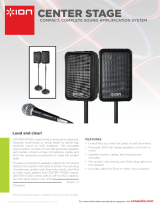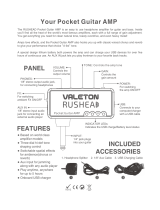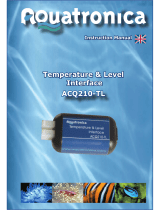Page is loading ...

Impact AG 6 - AG 8
Audiodesign Srl
Via dell’industria, 28 - 42025 CAVRIAGO (RE)
+39 0522 941444 - Fax +39 0522 942363
www.audiodesign-pro.com
OWNER MANUAL
Acoustic Guitar Amplifier
SETUPMEMO

PAGE 11PAGE 2
SCHEMATICDIAGRAM
Impact AG Serie Impact AG Serie
Acoustic Guitar Amplifi er Acoustic Guitar Amplifi er
Precautions:
Caution: When using any electric product , precautions should always be taken, including the
following:
1) Read carefully all instructions before using the product.
2) To reduce the risk, strict supervision is necessary when the product is used near
children.
3) Don't use the product near to water sources like sinks, kitchens, wet floors, pools, or
similar or when raining.
4) In case hearing losses or buzzing occur, please contact a doctor.
5) This product should be located so that its position does not interfere or reduce its
proper ventilation.
6) This product should be site away from heat sources such as radiators or any other
product that generate heat.
7) This product should be connected to a power supply line only of the type described on
the operating instructions. Check always the status of the power cable.
8) Unplug power supply when left unused for a long period of time. Don't draw the cable but
pull out the plug.
9) Make sure that power switch can always be easily reached.
10) Make sure that objects or liquids don't fall inside the product.
11) The product needs to be inspected by authorized or qualified personnel in case:
A- The power cable or plug are damaged
B- Objects or liquids fall inside the product
C- The product has been exposed to rain
D- The product doesn't appear to operate normally or exhibits a marked change in
performance.
E- The product has fallen and been damaged.
12) DON'T operate on the product, except indications on the user's manual . Please refer to
authorized and qualifi ed personnel for any other operation.
13) Caution: Don't place objects on the product's power cable or place it in a position where it
could be damaged or cause interferences. Improper installation could cause fi re risk and/or
personal injury.
Conformity:
Audiodesign Pro products comply with presently existing directives and standards.
After sales service:
All Audio Design PRO products have been inspected and tested before leaving the
factory and , if properly used, they will work for many years. However, in case of any
problem, please contact your dealer and inform about the defect you found.
In case it won't be possible to solve the problem with the dealer, the product needs
to be returned to our service centre.
INDEX
Warnings Pag. 2 Control panel AG 6 - 8 Pag. 6
Conformity
Pag. 2
AG 6 main features
Pag. 8
After sales service Pag. 2 Connection examples Pag. 10
Introduction
Pag. 3
Technical features
Pag. 11
AG 8 main features Pag. 4 Set Up Memo Pag. 12

PAGE 3PAGE10
CONNECTIONEXAMPLES
Ingresso Line IN Bilanciato
- Segnale
Schermatura
+ Segnale
Ingresso microfonico bilanciato
PIN1: Schermatura
PIN2: + SEGNALE
PIN3: - SEGNALE
Ingresso Line IN sbilanciato
Schermatura (-)
+ Segnale
Jack stereo
Right
Schermatura (-)
Left
CDPLAYER
MIC
Condenser
MIC
Smartphone
TABLET
PC
CDRECORDER
AMPLIFIER
Impact AG Serie Impact AG Serie
Acoustic Guitar Amplifier Acoustic Guitar Amplifier
Introduction
Congratulations for choosing an IMPACT AG series amplifier for acoustic guitars.
This series is featured by a great flexibility of use and by a particularly detailed and
precise sound.
The highlight of our products is given by the wide range of frequencies reproduced
by the woofer that allows tweeter to operate only in very high frequencies. The result
is a detailed and precise sound but never harsh and sharp.
With this product you will have the chance to make exactly the sound you would like
your audience to hear.

PAGE 9PAGE 4
Impact AG Serie Impact AG Serie
Acoustic Guitar Amplifi er Acoustic Guitar Amplifi er
Impact AG 8:
Acoustic guitar amplifier
Frequency response: 40 - 20.000 Hz
Max Power: 400 W
RMS Power: 200 W
Woofer: 8" - 200 mm
Tweeter: 25 mm silk dome
Weight: 11,3 Kg (protection bag included)
Sizes: 350x330x375 mm (LxPxH)
The versatility of this product allows you to use it both for practice or live
performances, both as a monitor and speaker of live performances.
Main Features:
4 input channels:
1) LINE IN 1: balanced or unbalanced input to which you can connect a guitar for
example.
2) LINE IN 2 - 3 : balanced or unbalanced input to which you can connect another
instrument. MIC IN : balanced input to which you can connect a dynamic microphone or
a condenser microphone. There is a "low cut" filter to tone down low frequencies to 120
Hz.
WARNING: NEVER CONNECT AN INSTRUMENT AND A MICROPHONE AT THE
SAME TIME ON THE SAME CHANNEL 2 OR 3. YOU MAY CAUSE DAMAGES ON
THE PRODUCT.
If you are using a condenser microphone that requires +48 V PHANTOM power,
SWITCH OFF the product, connect the microphone, press PHANTOM +48V button
and ONLY AFTER switch on the amplifier.
WARNING: If you don't follow the procedure in this sequence, you may cause
damages both to the microphone and to the product as well!!!
3) STEREO IN 4: this input consists of 2 RCA plugs: Left and Right , to which you
can connect an external source such as CD or DVD
MP3 IN: this input consists of a 3.5 mm STEREO mini-jack to which you can connect
an external source such as an iPod, an MP3 player, a Smartphone, a Tablet, a pc or
a laptop.
From these inputs you may listen to a song or background music.
SETTINGS:
All input channels have the possibility to:
* Adjust the input GAIN ( there is a red LED indicating "clipping" to avoid
saturation of pre-amp. Avoid this LED to light up and in case it lights up you have to
reduce the level).
* Adjust tones +/- 15 db (high shelve 10 KHz) (mid 3 KHz) (low shelve 100 Hz)
* Adjust signal level to effects (N.B.: fi nal result of effects is given by the
interaction of the effects on the channel and sum of total effects.
STEREO CHANNEL IN 3 has the possibility to adjust the GAIN
Further settings are possible on the mixed signal:
* Choose effect to use (all inputs) (**)
* Adjust general level of effects (N.B.: fi nal result of effects is given by the
interaction of the effects on the channel and the sum of total effects).
* Adjust signal amplification
(**) Available Effects:
1. Reverb Hall 1 2. Reverb Hall 2
3. Reverb Room 1 4. Reverb Room 2
5. Reverb Plate 1 6. Reverb Plate 2
7. Echo & FB 1 8. Echo & FB 2
9. Echo & FB 3 10. Echo & FB 4
11. Echo & FB 5 12. Echo & FB 6
13. Chorus & Rev 14. Flanger & Rev
15. Chorus 16. Flanger
4 outputs:
1) STEREO OUT: stereo output (full range) to which you can connect an external
recorder. Its level is set only by the rotary STEREO OUT control.
2) LINE OUT / DI OUT BALANCED are MONO BALANCED outputs (full range) to
which you can connect a mixer , an active speaker or an amplifier; level is adjusted
only by the rotary control LINE OUT.
This output is MONO so, signal from stereo inputs are mixed together .
3) PHONES: STEREO outlet (full range) for headphones: level is adjusted both
by rotary STEREO OUT control and PHONES LEVELS control. The channel is post
fader and consequently all settings made on each channel and generally on all
effects are present . These independent outputs can assure a great versatility of
use.
For example, you can keep IMPACT AG 6 volume to zero and listen with the
headphones all that has been connected to it. You have the possibility to record
what you are playing, adjusting independently recording volume from headset
volume or even use the IMPACT AG 6 as a monitor and connect it to a bigger system
(such as on stage installations) by adjusting the signal through the rotary LINE OUT
control.

PAGE 5PAGE 8
Impact AG Serie Impact AG Serie
Acoustic Guitar Amplifi er Acoustic Guitar Amplifi er
* Adjust signal level to amplifier
Further settings are possible on the mixed signal:
* Choose effect to use (all inputs) (**)
* Adjust general level of effects (N.B.: fi nal result of effects is given by the
interaction of the effects on the channel and sum of total effects).
* Apply and adjust Notch Filter (*) frequency
* Adjust signal amplification
(*) The Notch filter is a frequency dampener (from 100 to 250 Hz) that could cause a
resonance between the product and the acoustic guitar body.
This function is activated by pressing the dedicated button and in case of resonance,
you have to search the frequency to be dampened through its rotary control.
The Notch Filter doesn't act on DI OUT BALANCED, LINE OUT, STEREO OUT and
headphone but only on product's amplifi ed outlet.
(**) Available Effects:
1. Reverb Hall 1 2. Reverb Hall 2
3. Reverb Room 1 4. Reverb Room 2
5. Reverb Plate 1 6. Reverb Plate 2
7. Echo & FB 1 8. Echo & FB 2
9. Echo & FB 3 10. Echo & FB 4
11. Echo & FB 5 12. Echo & FB 6
13. Chorus & Rev 14. Flanger & Rev
15. Chorus 16. Flanger
4 outputs:
1) STEREO OUT: stereo output (full range) to which you can connect an external
recorder. Its level is set only by the rotary STEREO OUT control.
2) LINE OUT / DI OUT BALANCED are MONO BALANCED outputs (full range) to
which you can connect a mixer, an active speaker or an amplifier; level is adjusted
only by the rotary control LINE OUT. This output is MONO so, signal from stereo
inputs are mixed together.
3) PHONES: STEREO outlet (full range) for headphones: level is adjusted both by
rotary STEREO OUT control and PHONES LEVELS control. The channel is post fader
and consequently all settings made on each channel and generally on all effects are
present . These independent outputs can assure a great versatility of use.
For example, you can keep IMPACT AG 8 volume to zero and listen with the
headphones all that has been connected to it. You have the possibility to record what
you are playing, adjusting independently recording volume from headset volume or
even use the IMPACT AG 8 as a monitor and connect it to a bigger system (such as
on stage installations) by adjusting the signal through the rotary LINE OUT control.
Impact AG 6:
Acoustic guitar amplifier
Frequency response: 50 - 20.000 Hz
Max Power: 260 W
RMS Power: 130 W
Woofer: 6.5" - 165 mm
Tweeter: 25 mm silk dome
Weight: 9 Kg (protection bag included)
Sizes: 300x250x350 mm (LxPxH)
The versatility of this product allows you to use it both for practice or live
performances, both as a monitor and speaker of live performances.
Main features:
3 input channels:
1) LINE IN 1: balanced or unbalanced input to which you can connect a guitar for
example.
2) LINE IN 2: balanced or unbalanced input to which you connect another
instrument. MIC IN : balanced input to which you can connect a dynamic microphone or a
condenser microphone. There is a "low cut" filter to tone down low frequencies to 120 Hz.
WARNING: NEVER CONNECT AN INSTRUMENT AND A MICROPHONE AT THE SAME
TIME ON CHANNEL 2. YOU MAY CAUSE DAMAGES ON THE PRODUCT!!!
If you are using a condenser microphone that requires +48 V PHANTOM power,
SWITCH OFF the product, connect the microphone, press PHANTOM +48V button
and ONLY AFTER switch on the amplifier.
WARNING: If you don't follow the procedure in this sequence, you may cause
damages both to the microphone and to the product as well .
3) STEREO IN 3: this input consists of 2 RCA plugs: Left and Right , to which you
can connect an external source such as CD or DVD
MP3 IN: this input consists of a 3.5 mm STEREO mini-jack to which you can connect
an external source such as an iPod, an MP3 player, a Smartphone, a Tablet, a pc or
a laptop.
From these inputs you may listen to a song or background music.
SETTINGS:
The input channels line 1 and 2 have the possibility to:
* Adjust the input GAIN ( there is a red LED indicating "clipping" to avoid
saturation of pre-amp. Avoid this LED to light up and in case it lights up you have to
reduce the level).
* Adjust tones +/- 15 dB (high shelve 10 KHz) (mid 3 KHz) (low shelve 100 Hz)
* Adjust signal level to effects (N.B.: fi nal result of effects is given by the
interaction of the effects on the channel and the sum of total effects.
* Adjust signal level to amplifier

PAGE 7PAGE 6
3
4
2
5
6 7
98 10
12
11
16
17
21
22 23
24
25
14
15
18
11
11
29
26
27
19
20
28
1
12
13
14
11
15
16
17
18
19
20
21 22
23
24
3
4
2
5
6 7
98 10
25
26
27
CONTROL PANEL
CONTROL PANEL Impact AG 6
CONTROL PANEL Impact AG 8
REAR PANEL
Power Cable Connection
Switch
Impact AG Serie Impact AG Serie
Acoustic Guitar Amplifi er Acoustic Guitar Amplifi er
1. Microphone inlet/s
2. Microphone channel Low Cut
3. Line In
4. Gain
5. Clipping warning Led
6. High tones adjustment
7. Mid tones adjustment
8. Bass tones adjustment
9. Channel effects level adjustment
10. Channel level
11. Stereo input (RCA connectors)
12. Stereo input (Jack stereo connector 3,5 mm)
13. Stereo input Gain (AG 6)
14. General Volume
15. Led showing amplifi er clipping status
16. Effect selector (see list)
17. General effects level adjustment
18. Led showing effects clipping status
19. Headphones output level (combined to stereo out volume (25)
20. Headphones 6,3 Jack Stereo connector
21. Balanced Line out XLR
22. Balanced Line out 6.3 Jack
23. Line out level adjustment
24. Stereo outlet (RCA)
25. Stereo outlet level adjustment
26. Phantom power input button and LED indicator
27. Switch on LED
28. Notch Filter switch on button (AG 8)
29. Potentiometer to choose Notch Filter operation frequency
/



